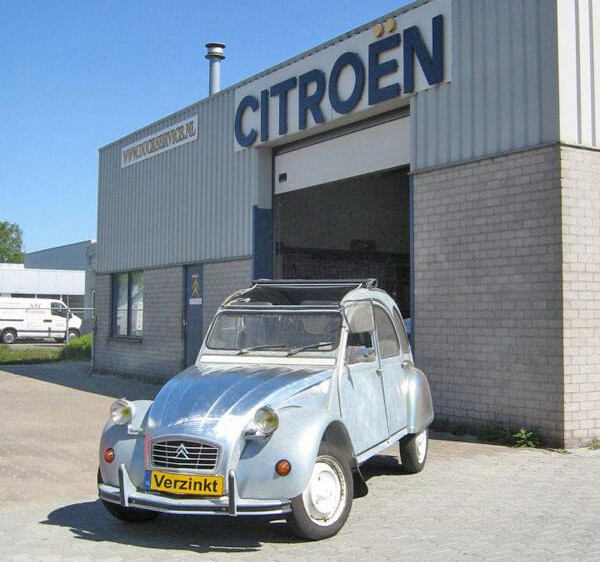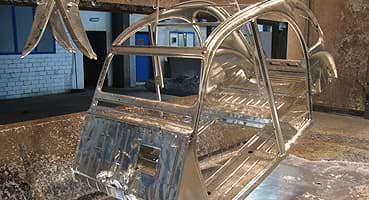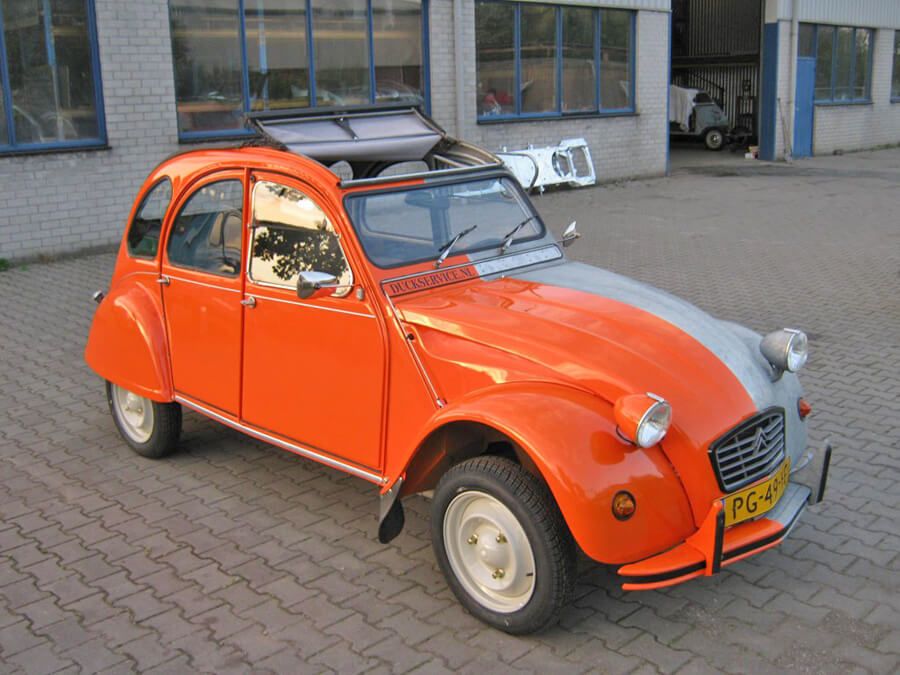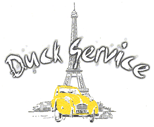Another 50 years of Citroën 2CV – the galvanised carriage
In the early 2000s, Duckservice started collecting and restoring 2CV carrosseries on a series basis. This has also worked very well for a long time. However, a well-used carriage can no longer be found in 2014. Several companies have also recently tried to make a new coach. These attempts were not bad, but encountered quite a few problems. in the meantime, there are some good new carriages on the market in 2016.
however, these are only equipped with a thin electrolytically applied zinc layer, because these carriages are made from factory with this sheet metal, it certainly does not have the rust-resistant effect that we are used to from thermally galvanized carriages. it is therefore advisable to have these new carriages galvanised thermally, so as to make sure that your investment will continue to be stainless for the next 40 years, the prices of these new carriages will start at 4850 euros. because these are not always available, the delivery time and the price may vary.
So what it means is that the whole process will become more difficult and therefore more expensive. The experiences over all this time and after more than 250 galvanized ducks on the road are so positive that we have decided to carry out only restorations with galvanized sheet metal parts. The difference between a normal restoration and a galvanized part is not even decisive in terms of price. The difference in longevity and usability of a galvanized duck exceeds many times the price difference.

However, we have noticed that it is difficult to explain to customers who have not studied the construction and steel quality of the duck like the one that once rolled out of the factory like us. That’s why here’s some insider information:
- A carriage of a 2CV has been welded first by factory. Then on the bare metal kit (without any rust protection) and then sprayed. What does that mean? If not every kit layer is removed (defrost), the car will always rust there again. Whatever amounts of paint or anti-rust means are spent on it. After all, no anti-rust agent will pull through the still present kit layer and thus protect the steel from rust.
- A 2CV was never made by lemon to last more than 10 years. It is actually very nice that there are still so many of them driving around. The car was made aware as a disposable item. If, against all odds, we want the ducks that have not been made for more than 23 years to last as long as possible, there is nothing left but to galvanize the whole thing. This is, after all, the best way to protect steel from rust.
- The way the sills, rain gutter frame, a-panel and the like are pointed in the factory makes it almost impossible to restore the 2CV several times. You simply can’t replace a tube six times without severely damaging the rest of the karroserie. The sheet metal is simply too thin to grind out and weld a part out of it every time. You can replace these hugely fragile sheet metal parts and then not without making a mess of it.
- A carriage is pointeded! In such a way that the minimum number of required welds is stuck. Without zinc running between it, it remains a weaker rust sensitive construction because these pointed welds always start working when the car is moving. This creates another rust spot, which one sees first when it is too late again.
The restoration of a 2CV carriage is as follows:
- The search for a suitable old 2CV with, for example, a chassis breakage, but with a carriage that is still in a reasonable to good condition, is underway. If a suitable 2CV is found, it will be disassembled in its entirety.
- The bare karrosserie is then chemically depained and then blasted to rid the carriage of all paint and tectonic residue. Where necessary, the carriage is repaired and reinforced.
- The carriage is then completely galvanised by immersion in a zinc bath of about 460ºC.
Experience has shown that this is the only way to save your 2CV from the rust devil. The price of a galvanised carriage depends on the availability of a suitable carriage, the number of working hours to be spent cleaning and repairing the carriage and the transport costs of the carriage to and from the galvanised carriage. A restored, galvanised carriage will therefore cost at least 5,500€
We distinguish 3 types: new carriages 4400€, galvanized carriage based on a new – 5950€ restored carriage while retaining original sheet metal 5,250€ and self-supplied material from 2,050€. This is not a cheap solution, but the only solution if you want to keep your 2CV for years to come. In addition, the availability of coaches that are eligible for recovery for galvanizing is becoming less and less. It is already the case that more and more work is going to be done in the “repair” of a carriage, and if you add up all the hours of the work, it can’t really work out either.
There will be a long way in this, and this has already been seen in recent years. For more information, please email us or call us. Even if you want to galvanize your own carriage, that also expresses itself in any lower costs.

Sink your own Duck carriage?
The cost of a galvanized carriage is based on: an old carriage from our stock, the welding, the devarnishing costs, the galvanizing, the transport and the finishing. If you want to galvanize your own carriage and do the welding yourself, that’s already 3 expenses less.
So these are the hours of machining, welding your carriage and the cost of a used carriage. The other costs of galvanizing your own carriage are based on the cost of transport, deflating and galvanizing. You will have to do the welding work and the replacement of the various plate parts yourself, but also the post-processing of the carriage, such as the tapping and the like.
This means that the costs are much lower than taking a galvanized carriage from us.

Depending on the state of your carriage, your expenses for galvanizing and uneaching will therefore amount to 2,050€ Note!!
If your coach has not been properly or properly loaded, the costs may be slightly higher due to.m. the work we need to adjust the soundness of the carriage. This is always done in consultation.
These expenses are determined for a Duck carriage, the expenses of another kind of carriage will be a different expense picture! We do a series of carriages a number of times a year.
Do you have any questions about this or would you like more information?
Please call or e-mail…
Despite Our Nearly 20 Years of Experience With Galvanizing Oldtimers. Is There Always A Risk On: Transport Damage, Light Heat Voltages In The Material, Zinc Residues In Places Where That Is Not Desired! In All Those Years This Rarely Comes Before, The Risk For This Always Takes On The Client (The Customer) Forking Gives No Guarantee To That, And So We (Duckservice) Doesn’t.
